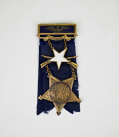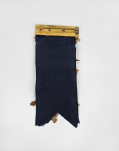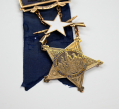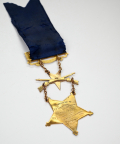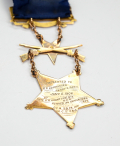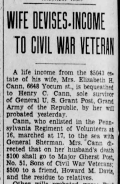site search
online catalog
VERY ATTRACTIVE GOLD G.A.R. POST COMMANDER’S BADGE: HE “MARCHED AT 17 TO THE SEA WITH GENERAL SHERMAN”
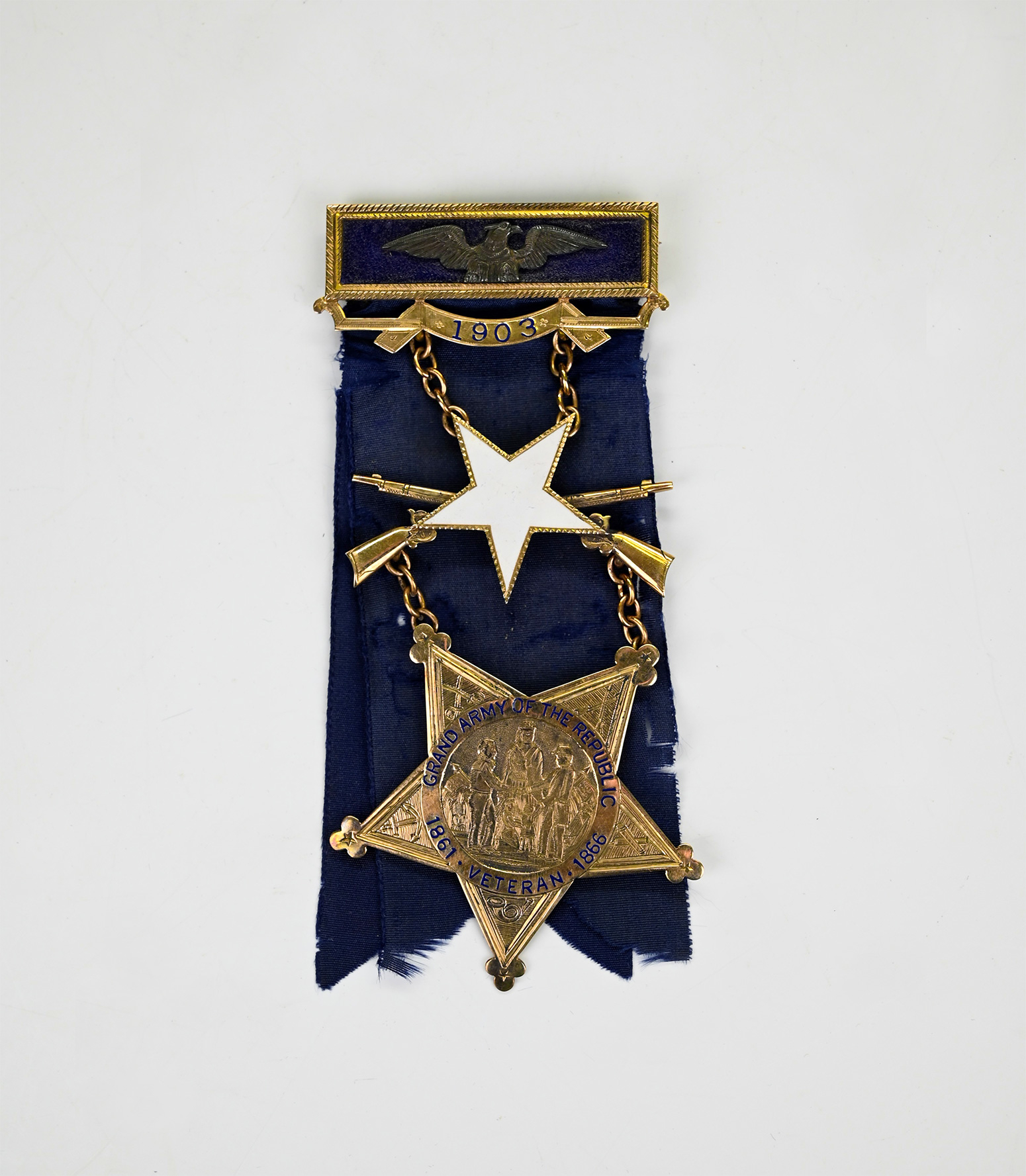
$2,250.00
Quantity Available: 1
Item Code: 30-2257
Shipping: Determined by Method & Location of buyer
To Order:
Call 717-334-0347,
Fax 717-334-5016, or E-mail
This beautiful, inscribed gold G.A.R. badge is a special presentation version of a Post Commander’s badge presented by the veterans to their Post Commander Henry C. Cann as he became a Past Post Commander. The badge uses an upper, pin-back frame incorporating the miniature shoulder strap with silver eagle indicating a post commander, on a dark blue background that matches the silk ribbon suspended from it. Attached to the lower edge of the shoulder strap is an angled scroll with the date 1903, the year of his service in that post, enameled in blue. From this in turn is suspended by two small chains a gold bordered white enamel star superimposed on crossed rifles, from which is suspended the gold star GAR badge planchet with both “GRAND ARMY OF THE REPUBLIC” and “1861 VETERAN 1865” rendered in blue enamel lettering.
The reverse of the badge omits the standard corps badges and is plain, with a presentation in small block letters reading: “PRESENTED TO / P.P. COMMANDER / HENRY C. CANN / JANY. 5, 1904./ BY/ GEN. U.S. GRANT POST. No. 5./ G.A.R. / SERVED AS COMMANDER / 1903/ CO. B 29 PA. INF. / CO. C. 17. V.R.C.” The letter follows the lines of curving scrolls with various flourishes, except for the date of presentation, which in a straight line at center.
U.S. Grant GAR Post 5 was in Philadelphia. Henry Clay Cann (1848-1935) enlisted in that city on 2/16/1864 at age 16. Army records list him as 18, which might indicate he lied about his age or, just as likely, he had a parent or guardian’s permission and the “18” was a matter of army bookkeeping. He listed himself as a button maker, and was described as 5’2” tall, with a light complexion, gray eyes and brown hair. The 1860 census indicates his father was a ladies’ lace maker, and finds him living with both parents and two older brothers, the eldest a carpenter’s apprentice. He mustered into Co. B of the 29th Pennsylvania as private as of the same day, transferred to Co. C 17th Regt. Veteran Reserve Corps (VRC) on 1/16/65, and was discharged from that organization 7/25/1865.
At the time of his enlistment the 29th Pennsylvania was serving in the Army and Department of Ohio and Cumberland in the 2nd Division of the 12th Army Corps, which had been ordered west after the defeat at Chickamauga in September 1863 and melded with the 11th Corps (also sent west at the same time) in April 1864 to become the 20th Corps. That corps retained the 12th Corps star as their corps badge, and in both assignments the 29th served in the second division, explaining white color of the star on Cann’s badge, with the crossed rifles indicating service in the infantry, even if technically the postwar branch of service insignia. During the time Cann was a member, the regiment saw action at Wauhatchie, Lookout Mountain, Ringgold, Resaca, Dallas, Pine Knob, Kennesaw Mountain, Peach Tree Creek and a number of smaller engagements in the lead to the siege and final battles around Atlanta. In mid-November it took part in Sherman’s March to the Sea, and in December was at the siege and occupation of Savannah. A 1935 newspaper notice mentions his enlistment at age 16 and that he, “marched at 17, to the sea with General Sherman.”
His immediate postwar career is unclear, but he seems to have returned to Philadelphia and live there the rest of his life. He married the widow of another veteran in 1876, who had a daughter, but does not seem to have had children of his own. She is listed as a dress maker in 1910 and he as a stone cutter. At his death in 1935 he was the sole survivor of US Grant Post 5. His death certificate lists him as a “stone cutter” and “soldier,” which says something of his pride in his army service.
The condition of the badge is excellent, with just some slight fraying to the ribbon, but excellent color to the ribbon and shoulder strap. The silver eagle on the shoulder strap shows a bit dark. The gold badge is bright, as are the blue and white enamel inlays, which are free from chips. [sr] [ph:m]
~~~~~~~~~~~~~~~~~~~~~~~~~~~~~~~~~~~
THIS ITEM, AS WITH ALL OTHER ITEMS AVAILABLE ON OUR WEB SITE,
MAY BE PURCHASED THROUGH OUR LAYAWAY PROGRAM.
CLICK HERE FOR OUR POLICIES AND TERMS.
THANK YOU!
Inquire About VERY ATTRACTIVE GOLD G.A.R. POST COMMANDER’S BADGE: HE “MARCHED AT 17 TO THE SEA WITH GENERAL SHERMAN”
For inquiries, please email us at [email protected]
Most Popular
Historical Firearms Stolen From The National Civil War Museum In Harrisburg, Pa »
Theft From Gravesite Of Gen. John Reynolds »
Cavalry Carbine Sling Swivel »
Fine Condition Brass Infantry Bugle Insignia »
featured item
RARE EBERLE 1796 CONTRACT MARKED BAYONET
This rare bayonet is marked by the maker in a sunken cartouche with raised letters on the base of the blade reading “Eberle.” Charles Louis Eberle emigrated to the U.S. from Germany with brothers George A. and Henry J. in 1794, arriving in… (1052-86). Learn More »



